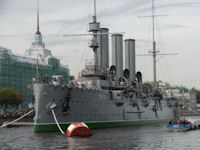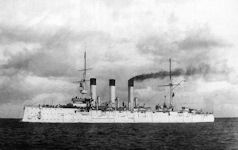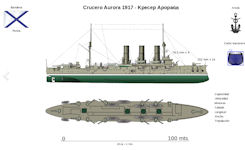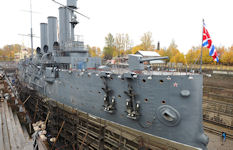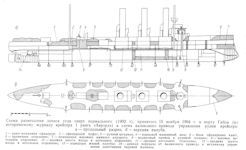Cruiser Aurora / Pallada class protected cruiser
In Soviet days, it was believed that an Aurora salvo had signaled the start of an armed uprising on October 25, 1917 (the Great October Socialist Revolution). The cruiser currently has the status of being the number one ship in the Russian Navy. It was on the 25th of October, 1917, at 9:40 pm, that its forward cannon fired a symbolic blank shot at the Winter Palace, the first in a sporadic barrage that accompanied the storming of the building, and the start of the communist revolution. After the palace had fallen, the ship's radio was used to broadcast Lenin's address, "to the Citizens of Russia", proclaiming victory for the proletarians.
Built between May 1897 and May 1900 at The Admiralty Shipyard in St Petersburg, the 6731 tonne cruiser was the last ship in the Pallada class of protected cruisers ( " Aurora ", " Diana ", "Pallada"). The Russian Navy had always been in the van of mechanical progress, and her ships reflect the latest devices of the inventor. In the matter of screws, however, some inconsistency was revealed, for while she adopted the triple-screw system in the Tzarevitch, Peresviet, Oslabia, and Podieda, and also in the Rossia, the Askold and the Pallada class, she has abandoned it in later ships. The Pallada class had three screws. The screws are three-bladed, and not particularly large. Steam was supplied by Belleville boilers. These had a speed of only 20 knots. Aurora was surpassed in speed by other ships of her type and time. The ship was modernized to receive significantly enhanced armament. As a result, she became superior in artillery firepower to Great War cruisers with similar displacement.
Aurora, of the Pallada class, did not seem likely to prove a flyer. On her first trial she came 1000 horse-power below the contract - a failure of 8 percent. The pressure was 150 lb. On a second trial with a pressure of 180 lb.—15 lb. over the nominal pressure she managed to scrape through a mile. As her foreign-built sisters - Variag, Bogatyr, and Askold - carried more guns, and had done easily about four knots more speed, it looked as though “made-in-Russia” warships were yet some way from ideal perfection. It was very doubtful whether the Aurora would ever succeed in passing 18 knots on service. This, as she is designed to chase fast merchantmen and liners and so forth, seemed insufficient.
A certain number of disasters marked the year 1901. The Peresviet has been ashore, but was got off unhurt. A big fire destroyed the cruiser Vitiaz; building at Galernii Ostrov, and damaged the Aurora of the Pallada class.
The Aurora served in the Russian fleet since 1903. It saw action in the Russo-Japanese War (1904-1905), the Russian Civil War (1918-1922) and in both world wars. With the advent of war in 1941, it's heavy guns were removed for use in the land defense of Leningrad. The cruiser was badly damaged during the defense of Leningrad (now St. Petersburg) during the Great Patriotic War against fascist Germany in 1941-1945. The ship herself was moored at the port in Oranienbaum and after constant shelling from the Fascist forces surrounding the city and numerous bombings, courtesy of the Luftwaffe, she sank in the harbor on the 30th September 1941.
The ship was repaired and moored at Petrogradzklaya Embankment in 1948. After World War II, the cruiser became a training base for the Nakhimov Naval Academy, and in 1956 it was converted into a branch of the Central Naval Museum. The Aurora was rescued owing to the reconstruction in 1987. The repairs included the replacement of the decayed underwater part of the cruiser. The bottom of the riveted hull was cut off like an old shoe sole, and the new steel nose copied the lines of the historical ship. During the middle of the 1980s, about 50 industrial enterprises of Leningrad participated in the renovation of the Aurora. Many operations were performed free of charge, and at weekends. The hull repairs were finished to celebrate the 70th anniversary of the Great October Revolution. The St. Andrew flag [Andreyevsky Flag], Russia’s traditional emblem, was once again raised over the Aurora in 1992.
According to the chairman of the St. Petersburg Club of Submariners, Igor Kurdin, it was not the technical problems that threaten the ship, but the absence of a trained crew. It was worthy of note that the navy crew of the Aurora was dismissed under Minister Serdyukov and replaced with a civil crew. The cruiser returned to the northern port city of St. Petersburg after overhaul wearing the Soviet coat of arms on its stern, a local naval plant spokesman said. "The decision has been made to keep the [Soviet] symbols," the spokesman said, recalling previous plans to replace them with representations denoting Russia. Igor Kudrin, an aide to the St. Petersburg governor, said Aurora was a site of cultural heritage and "this status allowed no exterior changes".
The world-famous Aurora cruiser, a symbol of the 1917 October Revolution reopened on August 3, 2016 after nearly two years of repairs. The renovation works are estimated to cost around 840 million rubles (approximately $13.2 million). The cruiser got a new renovated hull, a state-of-the art homemade fire-extinguishing system and 52 new video surveillance cameras, which practically exclude any unnoticed penetration on board the ship.
The newly restored ship, which supposedly gave the signal to revolutionaries to storm the residence of the Russia’s tsars, now also boasts an interactive exhibition. “If once upon a time the cruiser was generally only seen as a historical witness of the 1917 October Revolution, then now it is considered to be the most experienced veteran of the Russian naval fleet. With good reason – the Aurora has lived through the Battle of Tsushima, (the central encounter of the 1904-5 Russo-Japanese War, two revolutions and two world wars,” said a statement by the press service of the St. Petersburg Central Naval Museum.
The museum on board the cruiser, anchored on the banks of the Neva River, has grown in size from six to 10 exhibition rooms. In addition to the conning tower, the engine room and the boiler room, visitors can now examine the ship’s medical facility, where the Russian Naval Fleet used X-ray equipment for the first time. The exhibition’s main attractions include interactive exhibitions providing information on various aspects of the cruiser, including the ship’s design and steering system, its commanding officers and the daily life of the crew, which at one time numbered 570 men. Visitors can also learn about the general history of the Russian fleet and the Nakhimov Naval Academy, where the cruiser was used for many years as a training ship.
The cruiser "Aurora" will stay at the Petrogradskaya embankment in St. Petersburg for another 20-30 years, and during this time there will be no need for dock work on it. Anatoly Beloev, General Director of the Kronstadt Marine Plant (KMZ, part of the United Shipbuilding Corporation), spoke about this in an interview with TASS 22 June 2023 on the sidelines of the International Maritime Defense Show (IMDS-2023).
The ship was repaired at KMZ from 2014 to 2016. The repairs included updating the ship's structures and upgrading her safety and fire suppression systems. In particular, historical details have been updated, including the teak deck. “The restoration of the Aurora, without exaggeration, was a truly unforgettable event for the factory workers, and for all Russians. The handover ceremony itself, which took place under heavy rain and [with] powerful wind, was also memorable. But in such stormy weather, the water rose by 20 cm which helped the ship safely leave the factory harbor and make the transition to its anchorage in St. Petersburg," he said.
According to Beloev, the plant has developed good relations with the command and personnel of the cruiser. "We try to promptly respond to all the wishes and suggestions of the team. As you know, the cruiser's service life has been extended by 10 years as a result of repairs, but we are sure that the cruiser will stand for another 20-30 years and there will be no need for dock work during this time", he noted.
The Cruiser Aurora is in great shape, with a smart paint job and gleaming brass work, and stands today as the oldest commissioned ship of the Russian Navy, lovingly cared for by an active service crew commanded by a Captain of the 1st Rank, and still flying the navel ensign under which she was commissioned.
| Full load displacement | 6731 t |
| Length | 126.7 m / 412 feet |
| Width | 16.8 m |
| Draft | 6.2 m |
| Machine power | 11971 hp |
| Speed | 20.0 knots |
| Cruising distance | 4000 miles (7200 km) |
| Fuel | 964 tons of coal |
| Artillery armament (1917) | 152 mm (Canet gun) — 14; 76.2 mm (Lender air-defense gun) — 6 |
| Torpedo tubes | 3 (1 above water and 2 underwater tubes) |
| Weight of metal fired in one broadside | 267 kg per a salvo; 652 kg per a minute |
| Crew | 570 people (including 20 officers) |
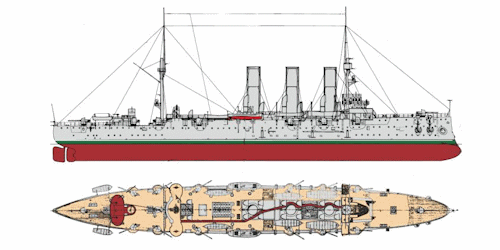
|
NEWSLETTER
|
| Join the GlobalSecurity.org mailing list |
|
|
|


